Weekend a Ceglie Messapica, Puglia. Città d’arte e terra di gastronomia
For the English version click here
di Cesare Zucca
Oggi vi portiamo alla scoperta di una delle città le cui origini si perdono nella notte dei tempi: Celie Messapica, gioiello pugliese dell’Alto Salento, nella provincia di Brindisi.
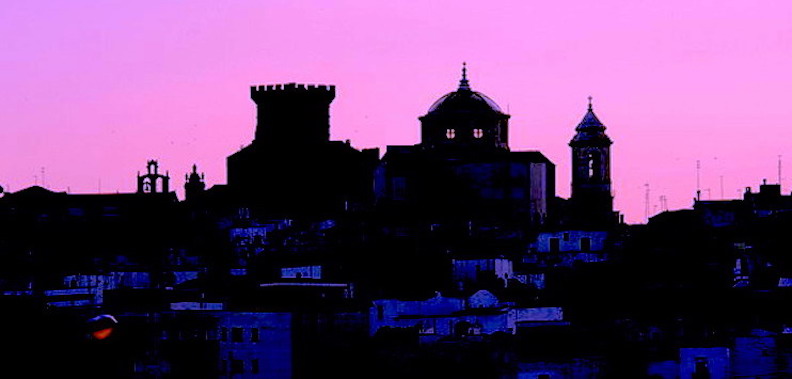
Troverete un vero scrigno di storia, impreziosito da bellezze architettoniche, angoli suggestivi viuzze dagli archi in pietra viva in un susseguirsi di corti e piazzette popolati da un sorprendente numero di ristoranti e osterie, vero paradiso per i buongustai!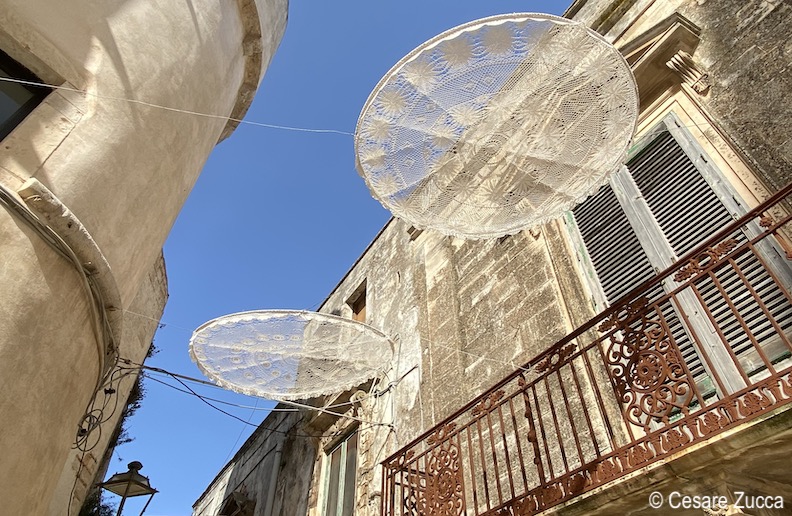
Celie si fregia dell’appellativo di “città d’arte e terra di gastronomia” per le tante testimonianze della sua storia millenaria e per la gastronomia locale, apprezzata e riconosciuta in tutta Italia.
Quale meta migliore per un “weekend del bello e del gusto”?
DA VEDERE
Il Castello Ducale e la Torre Normanna
Edificato intorno all’XI secolo, decorato dagli stemmi di famiglie nobili e ricco elementi storici ed artistici come il portale Cinquecentesco.
La Chiesa di San Domenico
In stile barocco del XVI secolo,della scuola del Bernini.

La Chiesa di San Rocco
Datata 1595, notevole esempio architettonico della facciata e delle tre navate del suo suggestivo interno.
Piazza Plebiscito e la “Torre dell’orologio”
Punto d’incontro della gente di Ceglie., chiude il centro storico medievale e apre a quello ottocentesco.
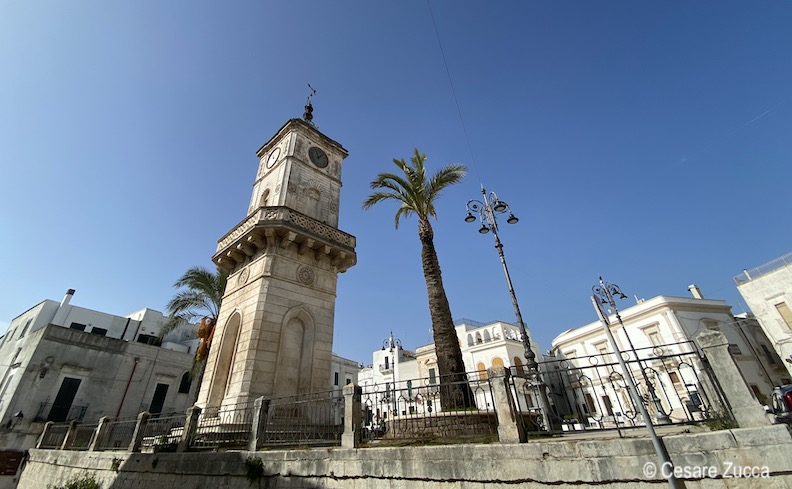
Weekend a Ceglie Messapica, Puglia. Città d’arte e terra di gastronomia
LA CUCINA DI CEGLIE
Estremamente varia, per le influenze che l’Altosalento ha ricevuto nel corso della sua lunga storia: messapi, greci, romani, normanni, arabi, saraceni, francesi e spagnoli si sono succeduti nei secoli. Tantissime provenienze: gli gnummarieddi” (Involtini di interiora di agnello alla brace) sono romani, il ragù è normanno, la cupeta(torrone di mandorle) è di origine araba, mentre dalla Grecia sono giunte le frise (ciambelle di pane raffermo che vengono immerse in acqua, e poi condite con olio, sale, oregano e gli irresistibili pummidori di pennula, pomodorini locali conservati in grappoli).
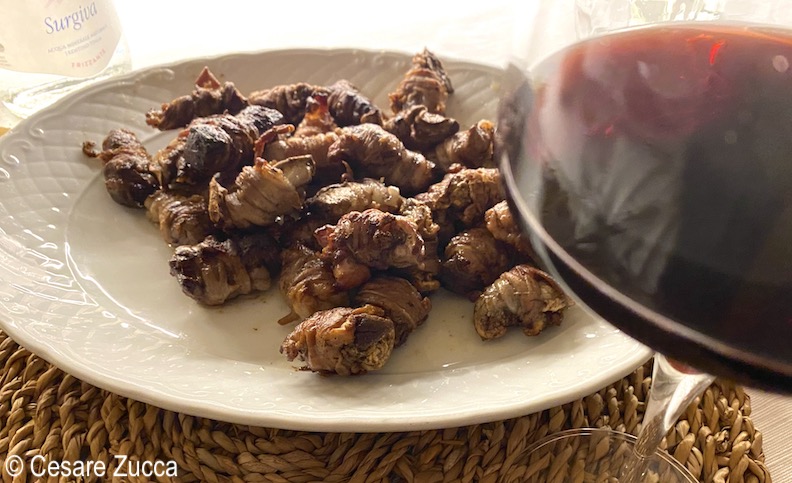
Le ricette sono tramandate di generazione in generazione, I piatti locali sono caserecci e genuini, profondamente legati ai prodotti della terra che offre legumi, verdure, ortaggi, frutta e il celebrato olio extravergine di oliva “collina di Brindisi” utilizzato per condire piatti tradizionali come purè di fave, tipico alimento dei contadini, cotto in pignata, recipiente di terracotta a forma di brocca.
Ogni mattina, come una volta, dai forni a legna in pietra esce la fragrante piddica tipica focaccia del mattino, con podorini e olive nere, mentre il gelato cegliese è rinomato.
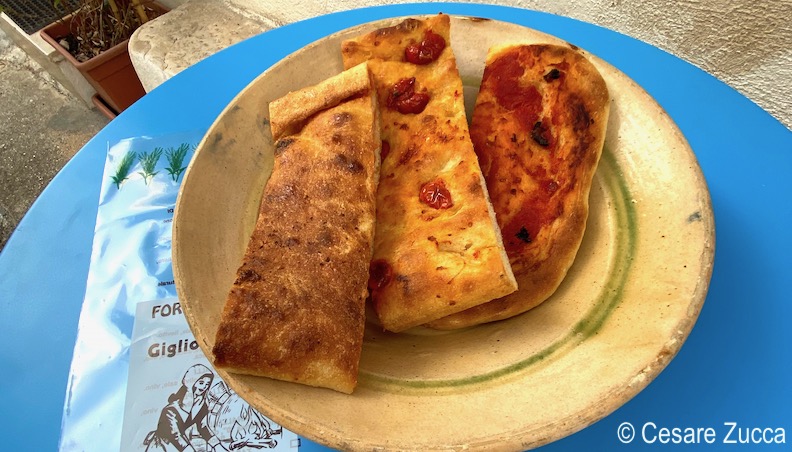
Piatto tipico per eccellenza è la pasta fatta in casa. Primeggiano le celebri orecchiette stacchiodde e i maccheroncini strascinati, serviti con sugo di pomodoro, di carne o con le tradizionali cime di rape e acciughe.
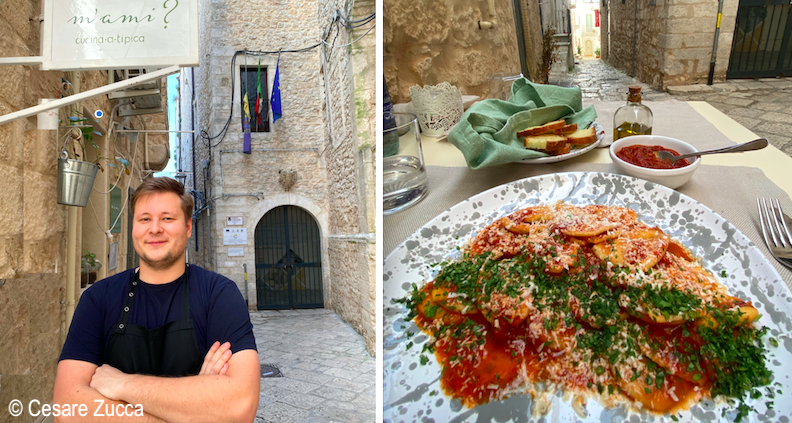
Le festività natalizie (appena passate, ma ricordiamolo lo stesso) vedono in tavola le pettole, palline fritte di farina e patate lesse, le “attorcigliate” friselle condite con miele, zucchero o vino cotto, mentre il biscotto cegliese, un pasticcino a base di mandorle tostate.
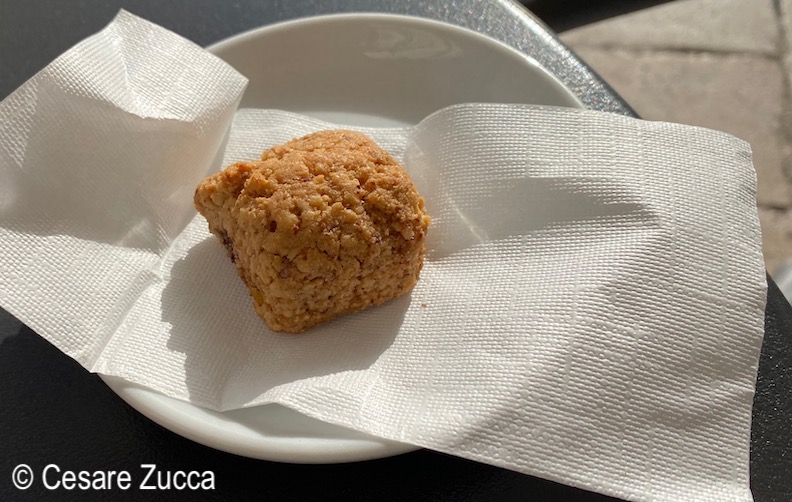
Panino superstar !
Gaetano, soprannominato “Re del Panino Cegliese” nella sua “Caocolleria” offre prodotti tipici della zona e, se insistete un po’, vi prepara “dal vivo” una delle specialità del luogo: il “panino Cegliese” farcito (rigorosamente in questa sequenza) da ventresca di tonno, capperi, soffice mortadella e provolone.

FORMAGGI DA OSCAR!
La Masseria Fragnite, la cui storia nasce nel 1700 , fino all’arrivo del Duca del duca di Ceglie che 1832 iniziò un processo di ristrutturazione e riorganizzazione produttiva, trasformandola in magazzini per la conservazione delle merci e in cortile per gli animali a cui verranno aggiunte le casedde e i tipici trulli per ospitare i braccianti e le loro famiglie.
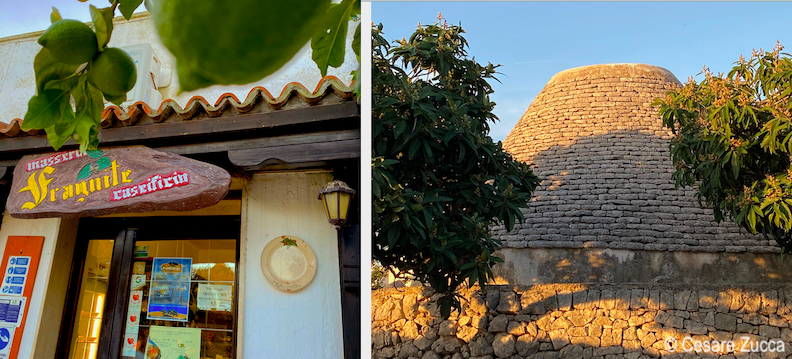
Fra i formaggi spiccano le ricotte asckuante, piccanti ma nel contempo delicate, il cacioricotta, un formaggio tenero e gustoso e il saporitissimo caciocavallo.

Perchè “caciocavallo”? Secondo alcuni il nome deriva dalla modalità di conservazione, dove, ancora fresco, viene appeso a cavallo su una trave. Secondo altri, invece, il termine ci riporta dall’usanza di portare al mercato le forme, a coppia, a dorso di un cavallo.

IL GUSTO IN TAVOLA!
Frisedde
Classici prodotti da forno: taralli con semi di finocchio selvatico.
Cartiddate
Simili a friselle affusolate sono condite con miele, zucchero o vino cotto (concentrato di mosto ottenuto mediante cottura).
Pane casareccio
La cottura avviene nei forni a legna in pietra. I panetti di colore bruno possono conservarsi anche per una settimana mantenendo la fragranza originale.
Piddichedda
Grande tarallo pasquale ricoperto di zucchero fuso (tipico di Ceglie)
Rosoli
Liquori prodotti in casa in maniera semplice e antica, particolare il rosolio di corbezzolo.

CELIE PARADISO “GOURMET”: I locali che abbiamo selezionato per voi.
Arrosteria Bogno Antico
Capatosta

Osteria L’Arco Antico
Trattoria L’acquolina
Eno Cocus – Acini e Carbone

DOVE DORMIRE
Nel centro di Ceglie Messapica
B&B Sant’Anna
Un bed & breakfast e due monolocali dal fascino delle tradizionali case in pietra dell’800, nel pieno centro storico affacciato su un gardino privato,
Sassi bianchi alle pareti, archi, caminetti e alti soffitti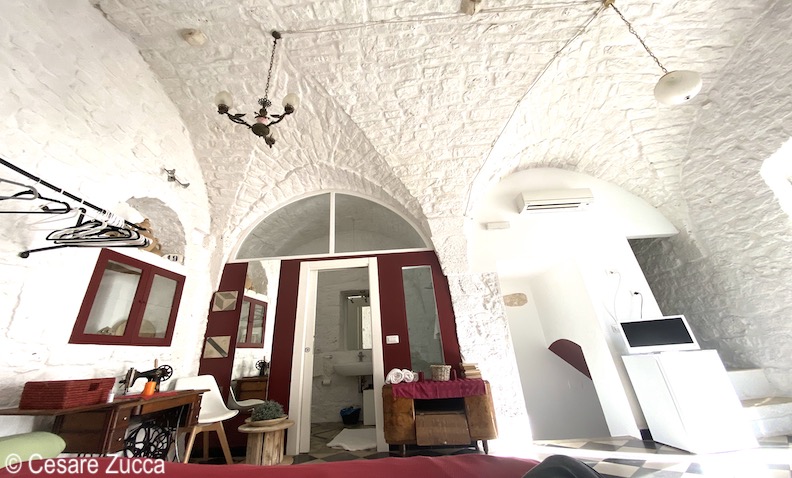
Le volte in pietra sono impreziosite dalle antiche nicchie naturali e cornici di un arredamento ricercato d’epoca, Soluzione ideale per un soggiorno che sappia di storia e confort, dal letto queen size , alla nuovissima doccia nella grotta, mentre qua e la oggetti che ricordano memorie di famiglia, come la macchina da cucire della nonna

Sotto il palazzo c’era l’antica cisterna pubblica alla quale la gente del quartiere poteva attingere l’acqua da una finestra esterna, oggi quelle nicchie sono degli armadi speciali. La prima colazione con biscotti, crostate, pane e dolci fatti in casa portata in terrazza dalla deliziosa Pamela Filomeno che gestisce e cura queste strutture. con passione e amore. Gli alloggi sono climatizzati e dotati di TV LCD e bagno privato.
Per chi cerca “qualità-prezzo”, questi alloggi si adattano perfettamente-.
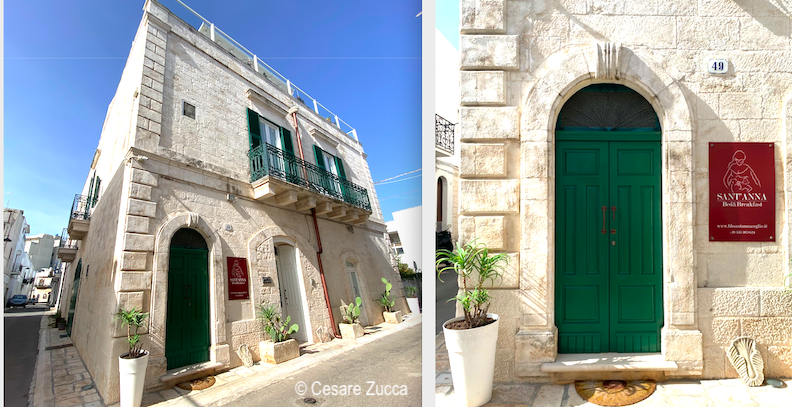
In una meravigliosa masseria
Masseria Camarda
Nata alla fine del 1800 come centro agricolo, si era poi specializzata nella produzione di olio, grano, ortaggi, legumi e le sue ampie stalle ospitavano capre, pecore e mucche.
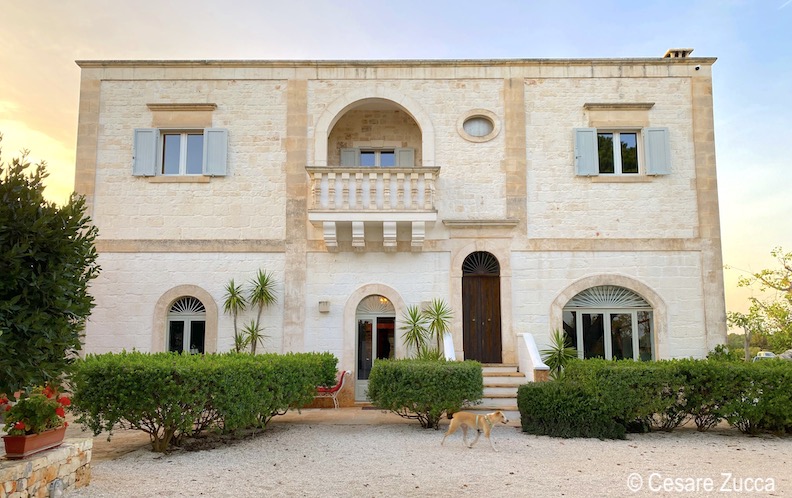
La Ferrari e la Puglia, le passioni di Cesare Fiorio.
Nella Masseria incontro Cesare Fiorio, grande campione automobilistico con la Lancia nei rally e in F1 con la Ferrari e le altre squadre, nonchè conquistatore dell’oceano Atlantico con nave Destriero. Oggi Fiorio vive a Celie, in Puglia, una terra che amava a tal punto da volerla far conoscere a tutti.

“Dai motori da corsa sono passato al trattore agricolo, racconta Fiorio, in cerca di una dimensione quasi ormai perduta, senza lo stress degli affanni quotidiani dove si gode la tranquillità degli antichi rapporti personali, del cibo sano e genuino e delle magiche atmosfere che queste terre sanno ancora creare.”
“Un luogo, mi spiega Fiorio, che rappresenta una scelta di vita e il piacere di condividerne la tranquillità, i profumi e i colori della campagna salentina”
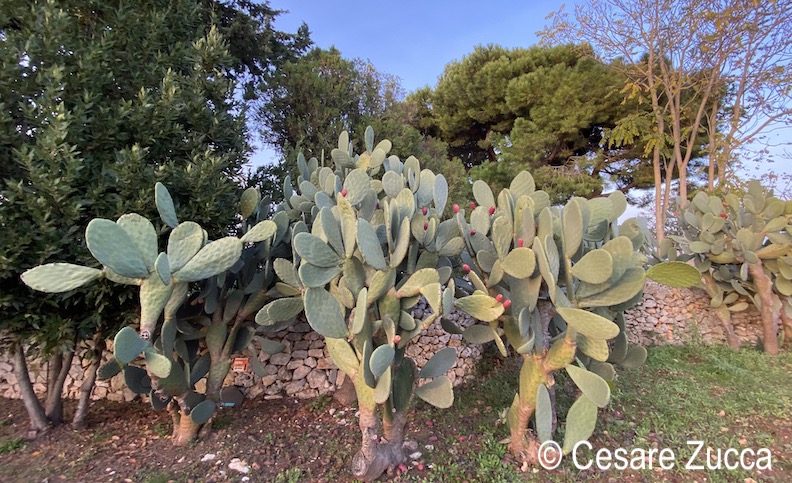 La masseria offre eleganti alloggi all’interno dei caratteristici trulli e ricavati in antiche stalle in pietra con le tradizionali volte a botte. La piscine è posizionata in mezzo ad un frutteto dove, oltre alla vigna, sono presenti alberi di ciliege, melograni, albicocche, pere, cachi, fichi verdi e neri, fichi d’india, mandorli, nocciole.
La masseria offre eleganti alloggi all’interno dei caratteristici trulli e ricavati in antiche stalle in pietra con le tradizionali volte a botte. La piscine è posizionata in mezzo ad un frutteto dove, oltre alla vigna, sono presenti alberi di ciliege, melograni, albicocche, pere, cachi, fichi verdi e neri, fichi d’india, mandorli, nocciole.
Non poteva mancare l’automobilismo: nella grande grande sala in pietra spicca la carrozzeria della Ferrari F1 di Mansell, vincitrice del GP del Brasile, mentre Alessandro e Maria Paola Fiorio sono gli ideatori della Fiorio Cup. Con otto piloti che si sfidano su un percorso realizzato all’interno del comprensorio della proprietà.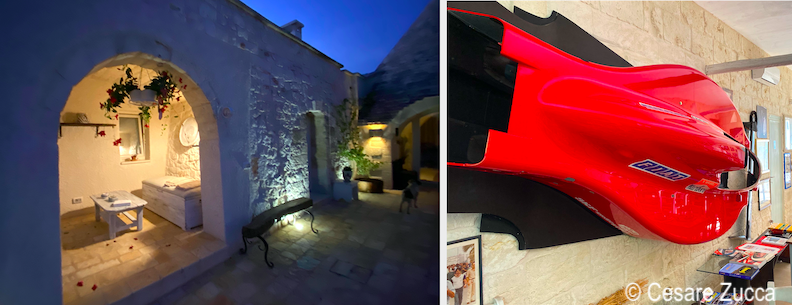 Tutt’intorno, Intorno si estende una vasta la campagna dove viene prodotto l’olio extra vergine di oliva di qualità superiore al vino primitivo, grano tipo “senatore Cappelli”, ingrediente base per la produzione delle tipiche orecchiette pugliesi, ortaggi, foraggio, frutta , noci, mandorle, nocciole, capperi, ceci, lupini .
Tutt’intorno, Intorno si estende una vasta la campagna dove viene prodotto l’olio extra vergine di oliva di qualità superiore al vino primitivo, grano tipo “senatore Cappelli”, ingrediente base per la produzione delle tipiche orecchiette pugliesi, ortaggi, foraggio, frutta , noci, mandorle, nocciole, capperi, ceci, lupini .

In vendita presso la Masseria, potrete trovare passate di pomodoro, marmellate, i famosi fichi “maritati”, prodotti che vengono offerti agli ospiti nelle ricche colazioni del mattino preparate dalle mani esperte di Sara Senofonte.

Che buffet! Tutto fatto in casa: torte, crostate alla frutta, focaccia biscotti e gli immancabili taralli, chiamati anche scaldatelli, vero simbolo della cucina pugliese e “prinicipi ” della tavola
SUA MAESTA’ IL TARALLO
Tradizionali oppure aromatizzati con semi di finocchio, peperoncino, olive o pomodori secchi. Ottimi ottimi per uno snack, un aperitivo o con buon bicchiere di vino rosso.
Piccoli, furbetti e tentatori, dolci o salati, uno tira l’altro !
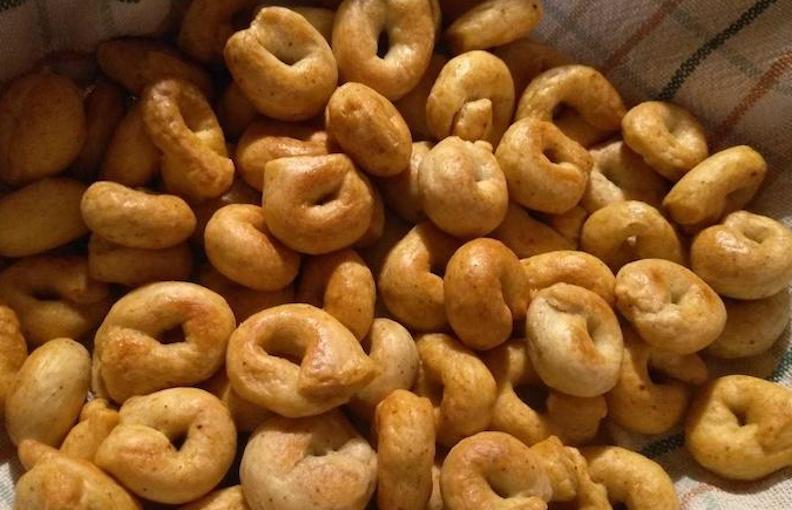
Che languorino, vero?
E visto che i veri taralli sono quelli fatti in casa, allora come farli a casa nostra?
L’importante per ottenere un buon risultato è seguire passo dopo passo quanto suggerito nella ricetta originale dei taralli pugliesi fatti in casa. di cui gentilmente Sara ci regala la ricetta.

TARALLI TRADIZIONALI PUGLIESI.
Ingredienti per circa mezzo chilo
500gr di farina 00 (Sara usa Senatore Cappelli)
160ml di vino bianco secco
160ml di olio rigorosamente extravergine di oliva
! cucchiaio da minestra di sale fino
Preparazione
Mischiare tutti gli ingredienti in una terrina
Lavorare con le mani fino ad ottenere un impasto liscio ed omogeneo.
Prendere un pezzo di pasta e formare dei filoncini lunghi 5 cm e spessi come il dito indice, unire le estremità formando degli anelli,
Disporre i taralli su una teglia e infornare a 180 gradi per 20 minuti.
Sfornateli, lasciateli raffreddare un po’ e… gustateveli!

La Masseria Camarda ha pensato di offrire ai suoi ospiti la cucina del territorio, vista, vissuta e rinterpretata dal valido Chef Maurizio, native di Torino con una estesa permanenza a nella cucina del suo ristorante a Cervinia per poi approdare a Ceglie, dove ogni sera prepara deliziose cene, esclusivamente per gli ospiti della Masseria.
L’ ho incontrato per una breve intervista

Buongiorno Maurizio, dopo 25 anni a Cervinia, sei approdato a Ceglie? Perché?
Forse ne avevo abbastanza del bianco, Tutta quelle neve…
Qui ho trovato una natura variopinta, meravigliosi tramonti, l’azzurro del mare e il calore dei Fiorio, La mia vita si è colorata.
Cos’hai “importato” della cucina piemontese nel tuo menu pugliese?
Mi sono lasciato ispirare dagli ingredienti della classica bagnacauda che ho trasformato in un sugo cremoso per condire la tipica pasta “appesa” di Ceglie.

Gli ingredienti locali che sono entrati nella tua mentalità gastronomica torinese?
Le verdure del territorio, specialmente quelle che coltiviamo qui in Masseria.
Le ho conosciute, sperimentate apprezzate, e ora sono ai primi posti della mia cucina.
Invece i fanalini di coda…
(ride) Molto di coda, visto che non li uso mai: rafano e wasabi. Non li troverai mai nei miei paitti e nemmeno nel mio frigorifero di casa.
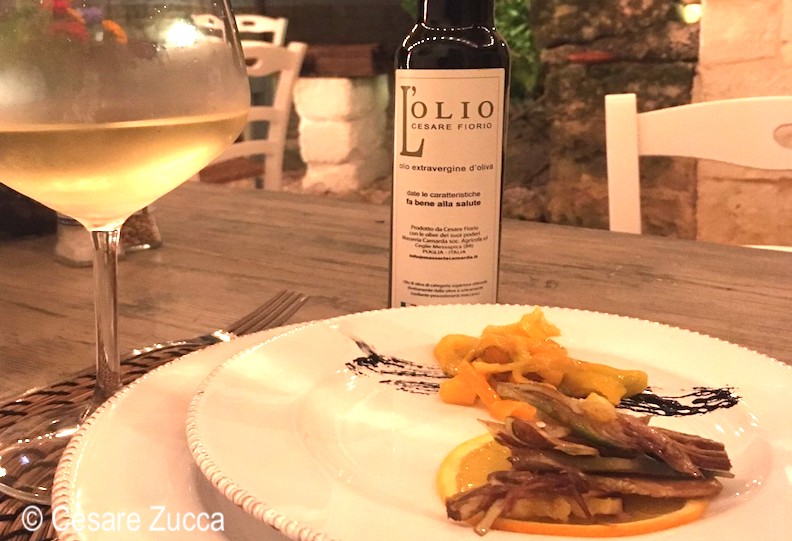
C’è un piatto che vorresti mettere in menu, ma…?
Eccome: gli gnocchi di patate come li faceva mio papà Bruno. Ho cercato di imitarli, ma non so come o perché, non mi sono mai venuti come i suoi…Squisiti e, devo ammettere, inimitabili!
La cena qui è riservata agli ospiti?
Esatto. Non c’è un menu scritto, tutto a voce, naturalmente tenendo conto di eventuali allergie o intolleranze. Alla base della Masseria, c’è la comunicazione con i nostri ospiti, anche nel proporre e nell’ordinare un piatto. Ah, dimenticavo qui non indichiamo i prezzi. Il prezzo lo fa l’ospite quando ha finito di mangiare, libero di valutare quale sia il prezzo giusto.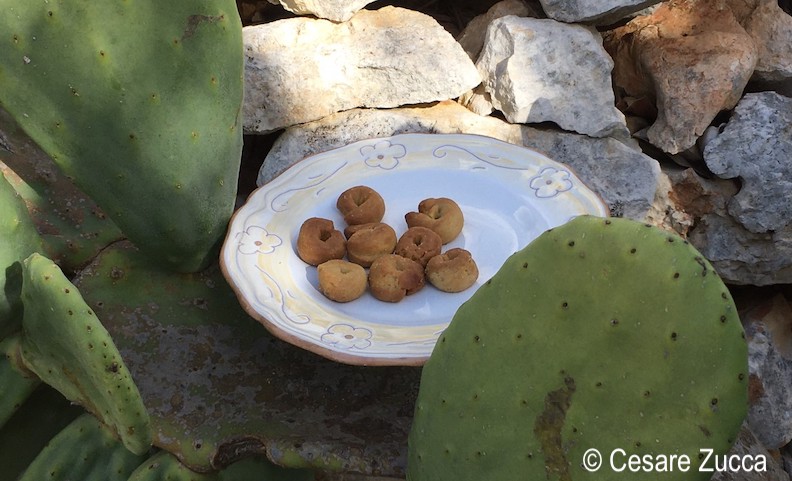
COME ARRIVARE A CELIE
Celia Messapica dista circa 40 kilometri da Brindisi. E’ facilemente raggiungibile in auto (propria o noleggiata) o in bus (circa un’ ora e mezza) oppure, come ho fatto io, contattare una guiida locale che oltre al trasporto, provvederà a farvi conoscere la città e i dintorni. Io mi sono affidato Michael’s Tours pilotato dall’ esperto e super dinamico Michele Miccoli, nativo di Ceglie, che mi ha raccontato storie, anneddoti e segreti della città, facendomela scoprire come solo una persona del posto può fare.
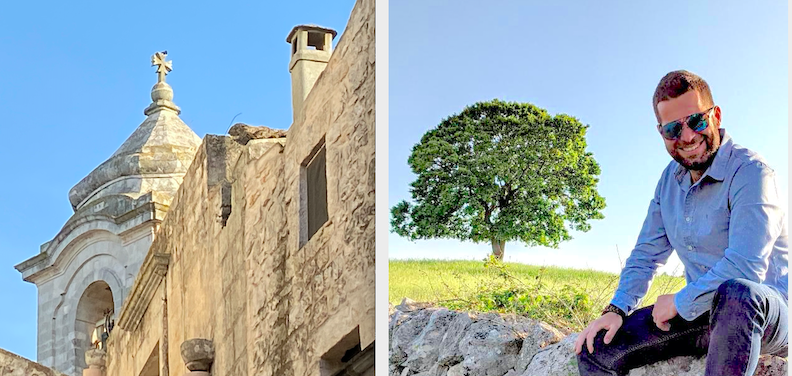
Grazie Michele! e grazie a Antonella Millarte, gentilissima
For the english version click Next>
Weekend in Ceglie Messapica, Puglia. City of art and land of gastronomy
by Cesare Zucca
Today we take you to the discovery of one of the cities whose origins are lost in the mists of time: Celie Messapica, an Apulian jewel of the Upper Salento, in the province of Brindisi.

You will find a real treasure chest of history, embellished with architectural beauties, suggestive corners, alleys with stone arches in a succession of courtyards and small squares populated by a surprising number of restaurants and inns, a true paradise for gourmets!
Celie boasts the title of “city of art and land of gastronomy” for the many testimonies of its millenary history and for the local gastronomy, appreciated and recognized throughout Italy.
What better destination for a “weekend of beauty and taste”?
TO BE SEEN
The Ducal Castle and the Norman Tower
Built around the 11th century, decorated with the coats of arms of noble families and rich in historical and artistic elements such as the 16th century portal.
The Church of San Domenico
In the Baroque style of the sixteenth century, from the school of Bernini.

The Church of San Rocco
Dated 1595, a remarkable architectural example of the façade and the three naves of its suggestive interior.
Piazza Plebiscito and the “Clock Tower”
Meeting point of the people of Ceglie., it closes the medieval historic center and opens to the nineteenth-century one.

Piazza Plebiscito and the “Clock Tower”
THE KITCHEN OF CEGLIE
Extremely varied, due to the influences that Altosalento has received during its long history: Messapians, Greeks, Romans, Normans, Arabs, Saracens, French and Spanish have followed one another over the centuries. Many origins: the gnummarieddi” (grilled lamb entrails rolls) are Roman, the ragù is Norman, the cupeta (almond nougat) is of Arab origin, while the frize (stale bread donuts that are dipped in water, and then seasoned with oil, salt, oregano and the irresistible pummidori di pennula, local cherry tomatoes preserved in bunches).

The “gnumareddi”
The recipes are handed down from generation to generation, the local dishes are homemade and genuine, deeply linked to the products of the land which offers legumes, greens, vegetables, fruit and the celebrated extra virgin olive oil “collina di Brindisi” used to flavor traditional dishes such as broad bean purée, a typical peasant food, cooked in a pignata, an earthenware jug-shaped container. Every morning, as in the past, the fragrant piddish typical morning focaccia comes out of the wood-burning stone ovens, with podorini and black olives, while the Cegliese ice cream conquered the podium of the International Ice Cream Trophy in Rimini.

Freshly taken out of the oven: the irresistible focaccias from Forno Gigliola
The typical dish par excellence is homemade pasta,
The famous orecchiette stacchiodde and maccheroncini strascinati stand out, served with tomato sauce, meat sauce or with the traditional turnip greens and anchovies.
My discovery, in a hidden alley, here are the “strascinati” with tomato and cacioricotta, served in the suggestive “M’Ami?” The chef is Piotr, of Polish origin, in love with Ceglie.

The Christmas festivities see on the table thepettole, fried balls of flour and boiled potatoes, the “twisted” friselle seasoned with honey, sugar or cooked wine, while the cegliese biscuit, a pastry made with toasted almonds

The “Cegliese biscuit”, local excellence
Superstar Sandwich!
Gaetano, nicknamed “King of the Cegliese sandwich” in his “Caocolleria” offers typical products of the area and, if you insist a little, he prepares “live” one of the local specialties: the stuffed “Cegliese sandwich” (strictly in this sequence ) from tuna ventresca, capers, soft mortadella and provolone cheese.

Gaetano and his famous “Panino Cegliese”
TOP CHEESES
Masseria Fragnite, whose history dates back to the 1700s, until the arrival of the Duke of Ceglie who in 1832 began a process of restructuring and reorganization of production, transforming it into warehouses for storing goods and a courtyard for animals to which will be added the casedde and the typical trulli to house the laborers and their families.

The ancient Masseria Fragnite
Among the cheeses, the asckuante ricottas stand out, spicy but at the same time delicate, the cacioricotta, a soft and tasty cheese and the very tasty caciocavallo.

Caciocavallo in progress
Why “caciocavallo”? According to some, the name derives from the method of conservation, where, still fresh, it is hung from a horse on a beam. According to others, however, the term brings us back to the custom of bringing the wheels to the market, in pairs, on the back of a horse.

Three excellent dairy products from Masseria Fragnite
TASTE ON THE TABLE!
Frisedde
Classic bakery products: taralli with wild fennel seeds.
Cartiddate
Similar to tapered friselle, they are seasoned with honey, sugar or cooked wine (must concentrate obtained by cooking).
Homemade bread
Cooking takes place in wood-burning stone ovens. The brown colored loaves can be kept for up to a week maintaining the original fragrance.
Piddichedda
Large Easter tarallo covered with melted sugar (typical of Ceglie)
Rosoli
Liqueurs produced at home in a simple and ancient way, in particular the strawberry tree liqueur.
Shopping: souvenirs from Ceglie, the festive luminous objects, the ceramic “pumi” lucky charms, a symbol of prosperity and the delicate Punto Antico embroideries
CELIE PARADISO “GOURMET”: The places we have selected for you.
Roast shop Bogno Antico
Capatosta
Braceria dei Santi, Capotosta
Osteria L’Arco Antico
The watering restaurant
Eno Cocus – Grapes and Coal
L’Acquolina, L’ Antico Arco, Eno Cocus


WHERE TO SLEEP
In the center of Ceglie Messapica
B&B Sant’Anna
A bed & breakfast and two studio apartments with the charm of traditional 19th century stone houses, in the historic center overlooking a private garden,
White stones on the walls, arches, fireplaces and high ceilings
The stone vaults are embellished by the ancient natural niches and frames of refined period furnishings, the ideal solution for a stay that smacks of history and comfort, from the queen size bed to the brand new shower in the cave, while here and there objects reminiscent family memories, like grandma’s sewing machine
Under the building there was the ancient public cistern to which the people of the neighborhood could draw water from an external window, today those niches are special cabinets. The breakfast with biscuits, pies, bread and homemade desserts brought to the terrace by the delightful Pamela Filomeno who manages and takes care of these structures. with passion and love. Accommodation is air conditioned and comes with an LCD TV and private bathroom.
For those looking for “quality-price”, these lodgings fit perfectly.

B&B Sant’Anna
In a wonderful farmhouse
Masseria Camarda
Founded at the end of the 1800s as an agricultural center, it then specialized in the production of oil, wheat, vegetables, legumes and its large stables housed goats, sheep and cows.

Masseria Camarda
Ferrari and Puglia, the passions of Cesare Fiorio.
In the Masseria I meet Cesare Fiorio, great automotive champion with Lancia in rallies and in F1 with Ferrari and other teams, as well as conqueror of the Atlantic Ocean with ship Destriero. Today Fiorio lives in Celie, in Puglia, a land that he loved so much that he wanted to make it known to everyone.

Cesare Fiorio in his Masseria
“I switched from racing engines to the agricultural tractor, says Fiorio, in search of an almost lost dimension, without the stress of daily worries where one can enjoy the tranquility of ancient personal relationships, healthy and genuine food and the magical atmospheres that these earths still know how to create.”
“A place, Fiorio explains to me, which represents a lifestyle choice and the pleasure of sharing its tranquillity, the scents and colors of the Salento countryside”
The farm offers elegant accommodation inside the characteristic trulli and housed in ancient stone stables with traditional barrel vaults. The swimming pool is positioned in the middle of an orchard where, in addition to the vineyard, there are cherry, pomegranate, apricot, pear, persimmon, green and black fig trees, prickly pear, almond and hazelnut trees.
Motor racing could not be missing: in the large stone hall the bodywork of Mansell’s Ferrari F1 stands out, winner of the Brazilian GP, while Alessandro and Maria Paola Fiorio are the creators of the Fiorio Cup, this year in its second edition. With eight riders who challenge each other on a course created within the property’s area. 
All around, there is a vast countryside where extra virgin olive oil of superior quality is produced, primitive wine, “senator” type wheat Cappelli”, basic ingredient for the production of the typical Apulian orecchiette, vegetables, forage, fruit, walnuts, almonds, hazelnuts, capers, chickpeas, lupins.

The pool
On sale at the Masseria, you can find tomato puree, jams, the famous “married” figs, products that are offered to guests in the rich morning breakfasts prepared by the expert hands of Sara Senofonte.

The succulent breakfast
What a buffet! All homemade: cakes, fruit tarts, focaccia biscuits and the ever-present taralli, also called Scaldatelli, a true symbol of Apulian cuisine and “principles” of the table
HIS MAJESTY THE TARALLO
 HIS MAJESTY THE TARALLO
HIS MAJESTY THE TARALLO
Traditional or flavored with fennel seeds, chilli pepper, olives or dried tomatoes. Excellent excellent for a snack, an aperitif or with a good glass of red wine.
Small, cunning and tempting, sweet or savoury, one leads to another!
How peckish, right?
And since the real taralli are homemade, how can we make them at home?
The important thing to obtain a good result is to follow step by step what is suggested in the original recipe of homemade Apulian taralli. of which Sara kindly gives us the recipe.

Sara and the Apulian taralli.
TRADITIONAL APULIA TARALLI.
Ingredients for about half a kilo
500gr of flour 00 (Sara uses Senatore Cappelli)
160ml of dry white wine
160ml of rigorously extra virgin olive oil
! soup spoon of fine salt
Preparation
Mix all ingredients in a bowl
Work with your hands until you get a smooth and homogeneous dough.
Take a piece of dough and form loaves 5 cm long and as thick as your index finger, join the ends forming rings,
Arrange the taralli on a baking tray and bake at 180 degrees for 20 minutes.
Take them out of the oven, let them cool a bit and… enjoy them!
Masseria Camarda has decided to offer its guests local cuisine, seen, experienced and re-interpreted by the talented Chef Maurizio, natives of Turin with an extended stay in the kitchen of his restaurant in Cervinia and then arriving in Ceglie, where every evening he prepares delicious dinners, exclusively for guests of the Masseria.
I met him for a short interview

Chef Maurizio, at the helm of the Masseria Camarda restaurant, reserved only for guests
Hello Maurizio, after 25 years in Cervinia, have you landed in Ceglie, Why?
Maybe I’ve had enough of white, All that snow…
Here I found colorful nature, wonderful sunsets, the blue of the sea and the warmth of the Fiorios. My life has become colourful.
What have you “imported” from Piedmontese cuisine into your Apulian menu?
I let myself be inspired by the ingredients of the classic bagnacauda which I transformed into a creamy sauce to flavor the typical “hanging” pasta of Ceglie.

A dish from Maurizio: the typical “pasta hung” with vegetables
The local ingredients that have entered your Turin gastronomic mentality?
Local vegetables, especially those we grow here in the Masseria.
I got to know them, tried them, appreciated them, and now they are at the top of my kitchen. (laughs) I never use them: horseradish and wasabi. You will never find them in my paitti or even in my fridge at home.

Cesare Fiorio oil accompanies the vegetables from the Masseria’s garden
Is there a dish you would like to put on the menu, but…?
And how: potato gnocchi as my father Bruno used to make them. I tried to imitate them, but I don’t know how or why, they never came to me like his… Exquisite and, I must admit, inimitable!
Is dinner here for guests only?
Exactly. There is no written menu, everything spoken, naturally taking into account any allergies or intolerances. At the basis of the Masseria, there is communication with our guests, even in proposing and ordering a dish. Ah, I forgot here we do not indicate the prices. The price is set by the guest when he has finished eating, free to evaluate what the right price is.
HOW TO GET TO CELIE
Celia Messapica is about 40 kilometers from Brindisi. It is easily reachable by car (own or rented) or by bus (about an hour and a half) or, as I did, contact a local guide who, in addition to transport, will introduce you to the city and its surroundings. I entrusted Michael’s Tours piloted by the expert and super dynamic Michele Miccoli, a native of Ceglie, who told me stories, anecdotes and secrets of the city, making me discover it as only a local person can.

Thanks Michael! and thanks to Antonella Millarte, very kind Head of the Puglia Promozione Press Office who suggested and made me discover this wonderful Apulian destination.